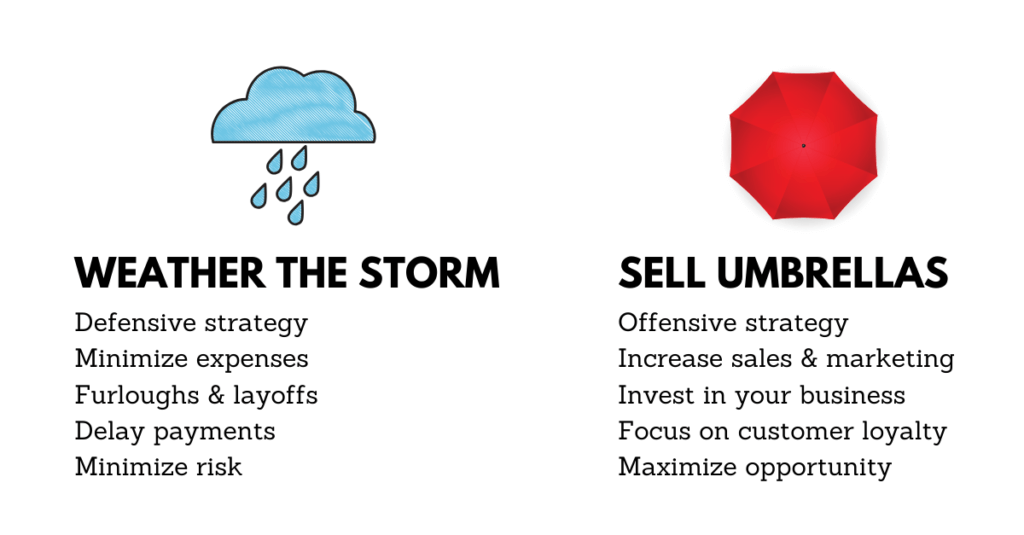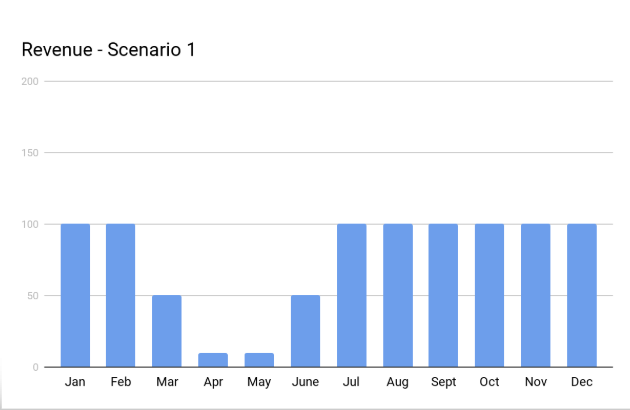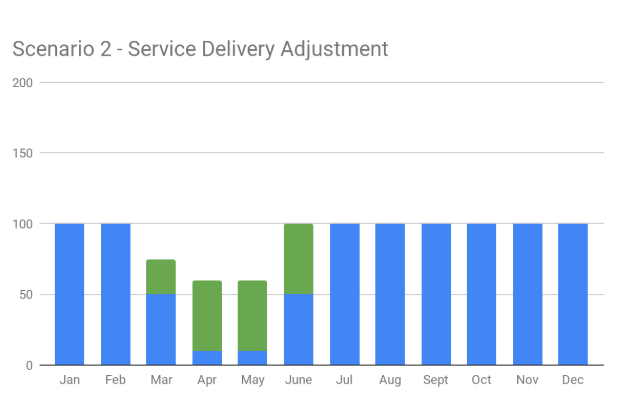Even in the worst situations, you can find opportunities to provide help and to do good — for the economy, for society, and for your business.
In the face of uncertainty, you can choose to weather the storm or to sell umbrellas.
As our Vice President of Software Consulting, John Horner has always spoken to business owners about the importance of knowing their own metrics, and, more importantly, knowing how to use them.
Our current economic hit has elevated that need, so we sat down with John to discuss what business owners can do with those metrics and how they can find solutions and opportunities within this crisis.
John explains the difference between offensive and defensive approaches to business, the necessity to remain agile, and how businesses have a unique opportunity to make technology work for their business in ways they may have never thought possible.
Seizing those opportunities can make all the difference for your business right now, and John encourages business owners to take charge before their competitors do.
“In the face of uncertainty,” he says, “you can either weather the storm or you can sell umbrellas.”
Weathering the Storm vs Selling Umbrellas
Many businesses have gone into full defensive mode. Their focus rests solely on minimizing risk and surviving this economic crisis.
I liken it to hunkering down and weathering a storm.
While the storm we’re in is certainly an unpredictable and destructive one, there are still business owners out there in the rain, selling umbrellas to the people who need them most.
These owners are targeting new markets. They are adapting their business models and the way they operate.
It’s these businesses that are doing more than weathering the storm that will come out of this stronger.

A defensive strategy is necessary, of course. You’ll want to know what your biggest expenses are and make sure you aren’t holding on to any unnecessary ones.
Chances are good, however, that if you’re only taking defensive measures, you’re not doing enough.
Sure, your business may survive this, you may succeed, but the best you can hope for is to succeed at not failing.
If you’re taking a “wait and see” approach, like many business owners are, I can guarantee that other business owners are still pushing forward.
I can guarantee it because I’m working with those business owners.
They know there’s risk, and they aren’t blindly charging ahead, but they are maximizing the opportunities for their business.
One of our customers, in particular, is really doubling down and spoke to us about his philosophy in a recent interview.
If other business owners are moving forward and you aren’t, your business, by default, is falling behind.
Below, you can see a fictional representation of a business’ revenue after implementing an effective defensive strategy. This chart shows the best case scenario for businesses that don’t take additional action.

Normal Revenue: $1200
Adjusted Revenue: $920
Revenue Change: -23.3%
If you have a good defensive strategy in place, your best case scenario is a dip in revenue with a gradual return to normal. This dip could last a few months or it could be much longer.
The truth is that none of us really know, but that doesn’t mean we can’t prepare.
If you adapt, stay agile, and remain open to our rapidly changing world, your business can recoup what would be losses.
You can be one of the businesses that finds the opportunities in the storm.
You can come out stronger, with loyal customers, increased productivity, and an improved business model.
Are you ready to start implementing an offensive plan for your business? The first, and most important, step to a good offensive strategy is knowing your numbers.
Know your numbers
We’re seeing drastic and significant changes in the world every day. You need to constantly monitor the pulse of your business, the external changes that are affecting it, and the impact your initiatives are making.
It’s important to know which initiatives are moving you in the right direction.
If your business doesn’t typically keep track of metrics or has inadequate metrics, now is the time to stop making excuses. Keeping track of your metrics is vital to the success of your company.
Just like with goals, you’ll want to make sure your metrics are SMART.

Every area of your business should have metrics. They act as a scoreboard for each aspect of your company. Regular cross-division meetings can help you keep track of how each area is performing and ensure your metrics and performance align with the overall goals for your organization.
Be clear about exactly what you need to know and keep track of. Everyone, at every level in your company, should be on the same page with what to look out for, what data to keep track of, and when and how to take action.
Regardless of how you keep track of data in the past, now, you’ll want to analyze twice a week, and compare data week to week. What changed this week from last week? With the rapid changes taking place right now, your approach to data needs to get much more granular.
Examples of metrics you can track:
- Revenue by Service Area
- New Customers
- Website Impressions
- Units Produced
- Revenue per Employee
- Customer Satisfaction
These examples can help you get started, but your own metrics, and the numbers you measure, will be specific to your organization.
Don’t accept bad data!
Whereas before, data entry may have taken a backseat to service or product delivery, it’s now time to recognize both as equally important.
You can’t succeed if you don’t know what success looks like. Your numbers are a representation of that.
Next, think about how your business can adapt your delivery methods to meet current needs.
Change delivery methods
Next, we can take a look at that same business’ annual revenue, but with added profits gained from adjusting service delivery methods.

Normal Revenue: $1200
Adjusted Revenue: $920
Service Delivery Revenue: $175
Total Adjusted: $1095
Revenue Change: -8.8%
By adapting to current demands and finding a way to provide your product or service offerings, you can make up for some of the expected revenue loss.
The way you’re doing business and the way your staff are working have probably undergone a fairly drastic change. You need to make sure you’re still able to deliver your products or services.
New methods aren’t going to build themselves, so take the time to figure out what this means for your business.
Some things that other businesses are doing right now include video services, low-touch delivery, remote work solutions, and even adjusting their target market.
Many industries are utilizing technology in entirely different ways. This includes everything from telemedicine, online learning, streaming concerts and movies, even instructional service calls.
It’s a big shift, but because all of us are experiencing it, customers are embracing technology in ways they never have before.
Many of us have seen telemedicine as a novel service offering, but not something we’d consider doing ourselves.
That’s all changed. For the most part, patients are now much more comfortable checking in with a doctor from the safety of their living room then entering a doctor’s office.
Even services that would seem impossible to deliver remotely, like dryer repair, are keeping people in business. Repair workers can conduct a consultation and walk customers through fixing an appliance, ushering in a new billable service.
Other businesses are offering curbside pickup and delivery options, restaurants have adopted take-out models, and many employees are working remotely.
A quick note on remote work: remember that, in the past, you’ve had more control over how safely employees used devices and company data. Now employees are using machines at home, and you have much less control over the safety of those devices. Make sure you’re utilizing best practices for remote work and cyber security.
Another thing to remember is that your target market has likely changed. With changes in working and recreation habits, shifts within industries, and service alterations, consumer needs have changed as well.
It’s vital to know who needs you most right now and what they need from you.
Prepare for the surge
Here, we see how the same business is able to make up for lost revenue by increasing capacity and taking full advantage of the post-storm surge.

Normal Revenue: $1200
Adjusted Revenue: $920
Capacity Revenue: $140
Total Adjusted: $1060
Revenue Change: -11.6%
In addition to gaining revenue from service changes, there will be an inevitable “surge” once this storm pasess, but you can only benefit from it if you’re prepared.
A surge is inevitable for most industries. While many things are being placed on hold because they aren’t essential, they’re still important. If someone needed a hip replacement before the pandemic hit, they’ll still need it after.
You may have heard jokes about it or have friends who’ve cut their own hair, but the reality is that, while not essential, it’s a service we all need. Hairdressers will be very busy turning us all back from cavemen.
Taking advantage of this surge means increasing your capacity now. If you plan to operate the same way you did this time last year, you won’t be prepared, and you’ll miss out on a lot of potential revenue.
Don’t let your competitors be the ones to gain those customers!
Be prepared, and benefit from those increased needs. You can prepare now with promotions, technology, and loyalty programs.
Market towards the spike. You can sell gift cards and offer promotional discounts now for products and services that people will be seeking out soon.
Be prepared for the larger capacity. Can the right equipment or software systems increase productivity? Look for ways to streamline operations now so you’re ready when customers need you.
Maintain your relationships with customers. Even if you aren’t able to serve customers right now, remain active on social media, send out email updates, and ramp up loyalty programs.
Maintain a positive presence in your customer’s minds so that they’ll know you’re there for them when they’re ready.

To increase the value of your loyalty program, give customers extra points for sharing your company’s products or services on social media.
Make the positives permanent

Normal Revenue: $1200
Adjusted Revenue: $920
Service Delivery Revenue: $475
Capacity Revenue: $140
Total Adjusted: $1535
Revenue Change: +27.9%
Finally, we see how our fictional business has actually increased their expected annual revenue by adjusting their service methods and taking full advantage of the surge.
If you’re in the position to adjust delivery methods and increase your capacity, you can benefit from all of the opportunities available to you.
By continuing to utilize the positive changes to your company, you can take what would have been a negative, and transform it into an opportunity to become stronger and more profitable.
I won’t pretend that we aren’t in difficult times. It isn’t easy to switch up your business model, especially at such a rapid pace. It isn’t easy to maintain a healthy perspective in times like this, but both of these things will pay off.
Having a healthy perspective isn’t about ignoring the difficulties we’re facing. It’s about finding ways you can help alleviate those difficulties. Even if your business isn’t providing something life-saving or sustaining, you’re providing a service that people need, that provides comfort or security.
Show customers that you care, adjust your business to meet current needs, and prepare for an upcoming surge in demand. The businesses who do this and stay agile, providing comfort and security through this storm, are the businesses who will come out stronger than they went in.
They’re the ones we’ll all remember. The ones we’ll reward with our loyalty.
What’s more, when your business stays agile and adapts to changing needs, you’re helping more than just yourself. Now is the time to show your employees, your customers, and the world that you’re here for them, and you’ll do whatever it takes to get them what they need when they need it.
Now is the time when the loyalty you show to others will directly influence their loyalty to you and your business, both now and for years to come.


